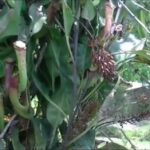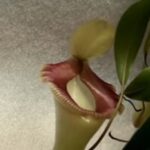As an Amazon Associate, this site earns commissions from qualifying purchases. For more details, click here.
Native to the Borneo lowlands, nepenthes bicalcarata is best known for the fangs – spurs actually – around its pitchers. Contrary to popular belief, n. bicalcarata is not difficult for anyone to grow, but it does require a specific approach to produce the best results.
Nepenthes bicalcarata prefers warm and humid conditions, preferably 85-90 F and 80-100% humidity. This lowland tropical pitcher plant grows well in a terrarium, greenhouse or sun room with bright, indirect light. Use only poor soil with these pitcher plants.
Nepenthes Bicalcarata Care Sheet
| Soil | Peat, perlite, sphagnum moss, soil has to be moist |
| Water | Purified, distilled, rainwater |
| Light | Partial shade, 6-8 hours, indoor lights are allowable |
| Food | Insects, freeze dried bloodworms, fish food |
| Temperature | 85-90 F (30-32 C) |
| Humidity | 90-100% |
| Dormancy | Not needed |
| Propagation | Leaf cuttings |
Soil
Nepenthes bicalcarata is usually planted in sphagnum moss, perlite and peat. Other nepenthes mixes are also suitable.
When you buy n. bicalcarata it is usually with sphagnum moss. You should use whatever soil the vendor bundled with the plant as it is probably the most suitable for that variant.
If you want to try something different, use only nepenthes potting media. The most common mixture is LFS with perlite, but LFS, peat and perlite are also good. Some prefer silica sand and add some orchid bark or vermiculite.
To keep it simple: if the soil mix is for nepenthes, it should work with n. bicalcarata. In fact any potting media for carnivorous plants is usually acceptable.
N. bicalcarata are usually sold bare root. Once you have set the plant in a pot, the media must be moist. If you are feeding a pitcher plant, do not get any food bits into the soil. Over time those leftovers will accumulate and could enrich the soil, which is bad for pitcher plants.
Pot Container
Nepenthes bicalcarata is well suited for a terrarium or greenhouse. It also grows well on sunny windowsills in a pot or anywhere outdoors.
This pitcher plant naturally grows in hot, humid locations such as swamps, damp vegetative areas etc. So when you get your n. bicalcarata, place it somewhere hot and humid as well. Whether you grow it in a pot by the window or in a terrarium like the CYS Excel,, make sure there is sufficient humidity and light present.
N. bicalcarata are usually shipped with a container. A pot may or may not be included but that is not a problem. You can use any 3-4 inch pot and that should be enough. Once you have added the soil, leave the plant on a south facing windowsill to catch light.
If you are going to use a terrarium or greenhouse, ventilation will be key. The enclosure has to be large enough for the plant – or plants if you have several – and there has to be enough room for each one.
Humidity is important for n. bicalcarata so make sure the terrarium or greenhouse provides the right level. The same thing with lighting and the temperature. In general it is easier to control environment variables in this enclosure, which is why thy are often used for lowland nepenthes.
Water
Water plays a key role in determining how long pitcher plants can survive. Not only how much water but the type you use is important.
A typical n. bicalcarata needs enough water to maintain soil moisture. The soil should always be moist regardless of the season. You may reduce water a bit during winter if plant activity slows down. Some n. bicalcarata do slow, but others do not. So if yours does not, water at normal levels.
Here are some tips on how to water nepenthes bicalcarata:
- Do not use the tray method. Sitting in water works well for Venus flytraps, sundews and some pitcher plants like sarracenia. For nepenthes bicalcarata however, overhead watering is better. Fill a bottle with water and spray freely.
- Nepenthes bicalcarata thrives in hot, humid conditions so water as often as necessary to keep the media consistently moist.
- Use only RO, rainwater, purified or distilled water. These pitcher plants do not handle tap water well.
- Too much water or the lack of it will both cause problems. Too much water leads to root rot and too little causes leaves and pitchers to dry. If the plant colors are vibrant and pitchers have liquids, you are using the right amount of water.
Light
N. bicalcarata grows in warm, humid swamps, bogs and similar locations. Under these conditions, n. bicalcarata is partially covered by foliage. This is what you should try to emulate when growing the plant.
For outdoors, place nepenthes bicalcarata in partial shaded light. For indoors, keep the plant in medium light. You can use artificial lighting if growing the plant indoors.
If your nepenthes is outdoors for instance, set the pot so that it is partially covered. While these pitcher plants prefer high temperature, too much heat can still cause damage.
If you are growing n. bicalcarata in a greenhouse or terrarium, set it up so the plant is never directly under sunlight. The same rule applies if you are using artificial lights. Do not point the fixtures directly at the plant. Light should reach the plant but not be directly on it.
You can use any indoor plant light, whether it is LED, fluorescent etc. Follow the instructions for their setup and take note of how your n. bicalcarata reacts.
Temperature
Nepenthes bicalcarata prefers 85-90 F (30-32 C) degrees. The minimum temperature should be 60 F (15 C) at night. While some plants may survive in lower temperature, they will not grow as fast.
Its temperature requirements are higher compared to nepenthes maxima and other pitcher plants. This is due to its natural habitat which is warmer compared to other nepenthes. However the heat is balanced out by high humidity so keep that in mind.
If you live in a warm humid area, n. bicalcarata should be easy to grow outdoors. If you are in a cooler region, it is best to raise the plant in a terrarium. You can make the terrarium warmer and increase humidity. You should be careful not to make it too warm, so there needs to be some ventilation, sufficient water and light.
Even without a terrarium you can still control the temperature around your n. bicalcarata. If it is in a pot on a windowsill, relocate the plant to a warmer spot. If it gets too cold, pick a sunnier location. As long as you live in a warm climate, expect the plant to grow quickly.
Humidity
Nepenthes bicalcarata loves a humid environment. Keep the humidity at 90-100%, certainly no less than 70%.
Because nepenthes bicalcarata grows in warm conditions, it needs humidity to retain soil moisture. When humidity is high, it helps balance the warmth so leaves do not dry out. If the air moisture is too low it could be fatal to n. bicalcarata.
One way to find out the humidity level is to touch its leaves (yes pitcher plants are safe to touch). If the leaves are dry or the pitchers have no liquid, humidity is too low.
If the plant is indoors you can control humidity with a humidifier. You can also use a fogger to achieve the same effect. A humidifier works well in conjunction with a terrarium too.
Nutrition and Feeding
With their “fangs” nepenthes bicalcarata is capable of eating large insects such ass yellow jackets, stink bugs, wasps and more. Outdoors, n. bicalcarata will can catch a lot of bugs in its pitchers. If it is in a terrarium,, hand feeding is necessary.
N. bicalcarata can be fed every 1-2 weeks. Aside from insects, fish and mealworms, you can also give it Maxsea fertilizer, heavily diluted in water. The typical mix is 1/4 teaspoon fertilizer per gallon of water, Feed to your nepenthes every two weeks.This should be enough to spur rapid growth.
Dormancy
Nepenthes bicalcarata does not require dormancy. However, growth may slow during winter so reduce watering. After winter, the plant starts growing at a normal pace again.
If you live in a warm region, it is fine to keep nepenthes bicalcarata outdoors. Move indoors if it drops below 60 F in winter. If not, you can grow it outdoors. If you do live with freezing cold, take the plant indoors. If temperature does not reach 85-90 F in summer, it is best to cultivate n. bicalcarata in a terrarium so you can control the humidity.

My fascination with carnivorous plants began many, many years ago with Venus Fly Traps. Now I am more than happy to impart what I know with other enthusiasts and those who are curious about meat eating plants.



